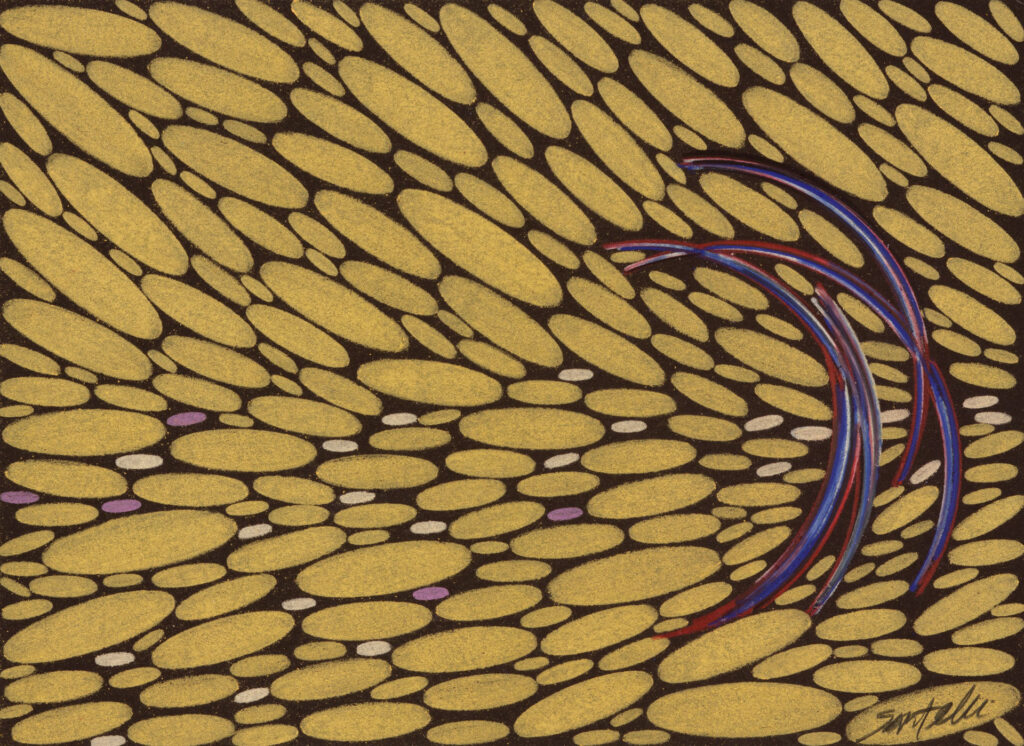Santelli’s stream of consciousness

Minstream 17, Bill Santelli, colored pencil on paper
A three-person exhibition, Constellations, featuring paintings, drawings, and installation works by Sara Baker Michalak, Bill Santelli, and Mizin Shin will open shortly at Main Street Arts. It’s curated around the commonality of their work. Each, in different ways, builds a patterned image—loosely or with gridded regularity—that aims for the cosmic. As with every painting, the particulars matter because of their unity within the whole work, but in this case the particulars are mostly effaced within the flow of what’s happening everywhere else.
I’ve known Bill for years and was pleased to hear that he’d been invited into this show, having seen these new drawings on Instagram over the past year. Like his Prismacolor drawings in the Path series, these explorations of thought—the honeycomb of ovals suggestive of thinking’s fragmented flow—represent a patient, repetitive and extremely disciplined practice using the simplest combinations of tone and line. In the Path series, he creates long, languid and pliant streaks of color that evoke tall grass bending in a breeze, where each line creates cells of pale monochrome. They are like leaded panes of stained glass, but also look surprisingly like glimpses of dawn breaking over wetlands.
In these newer drawings, his colors are even simpler and richer, and the minimalism of the Path drawings has been reduced to a grid of loops with less reference to nature. When I asked him to describe what went into the drawings, he wrote “I began these drawings after reading about the concept of ‘mindstream’ in Buddhist philosophy, which is described as . . . the moment-to-moment flow of sense impressions and mental phenomena.”
He offered some background on his preoccupations in this work. He’s been reading a lot about Krishnamurti—a long-standing source of inspiration for his work—and watching videos of his talks. Krishnamurti’s focus consistently returned to a mindfulness that pulls back from the conscious mind’s endless jabber, the flow of that in-the-head narrator. He urged his listeners to impartially observe the operation of their own minds in an attempt to disengage from the grip of reactive thought and action. (Isn’t that a good phrase for our current national disease?) These drawings, for Santelli, grapple with his awareness of his own thought bubbles, as it were, floating past as he meditates or walks—pulling him away from being fully present and aware. Krishnamurti’s central point is to get his practitioner to disengage and become an observer of everything the mind is doing–to simply be aware of it all, and that awareness alone will awaken a kind of intelligence that isn’t simply conscious reasoning. It’s a bit like the Greeks referred to as nous. If you see yourself clearly, down to the roots of your behavior and thinking, both of those are changed as a result of that clarity.
Not that this is necessarily what Santelli is attempting to represent here. But it’s related. As he puts it in his statement for the show: “As with all my work, the drawings are an introspective process – I find myself reflecting on the inner journey, about letting go of old forms and opening to new ones, of balancing the path inward with the pathway outward. The choreography of shapes and colors creates a motion across the paper, a fluid yet gently turbulent “mindstream” that arises and passes away in each moment.”
As with the Path series, these drawings are in colored pencil—mostly Prismacolors in the ultramarine and dark gold images. He’s also working with Caran d’ache Luminance pencils in the brighter work for “a palette shift.” He says, “The Caran d’ache colors are really nice, but each pencil costs almost $5!” he joked. When I asked about his shift from the Path series to this new mode, he said he continues to do the Path work, but they take much longer to complete.
He’ll be showing one 22 x 30 inch drawing in this Mindstream series and the rest are much smaller. For those he worked with strips of paper cut from larger sheets used with the bigger work. “I had these strips laying around and I was able to get the most individual paintings by cutting the strips down to 5.75” x 8”. I’m happy with what I’m doing in the Mindstream work.”
I asked why the ovals? “I have used geometric shapes (circles, squares, triangles, rectangles) in other series of drawings I’ve done. But the oval, hardly ever. Visually, I think of the oval more as a form for these considering drawings (inspired by forms and shapes I was seeing on my morning walks), and also what I was trying to convey – which was (and here he quoted his statement in progress) “a choreography of shape/form moving across the paper – each individual shape/form representing a separate thought, that would arise and fall away as I worked.”
Comments are currently closed.